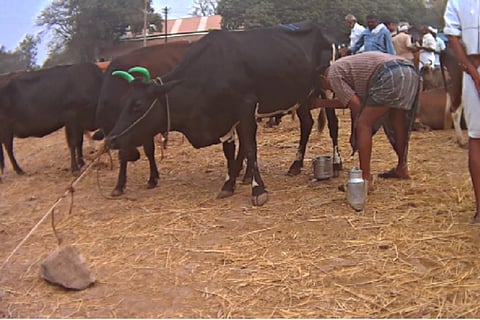

Milk is a staple in almost every household. Rich in nutrients like calcium and versatile in use, it is considered a good source of energy for all ages. But did you know that the milk you consume could be making you vulnerable to hormonal imbalance, antibiotic resistance, toxicity and more?
The reason? The way the animals producing milk are treated.
A study by NGO Animal Equality surveyed 107 small (1-50 animals), medium (50-200 animals) and large dairies (200-500 animals), 8 slaughter houses, 11 cattle markets and more, across India. The states surveyed include all five southern states, as well as Haryana, Punjab, Uttar Pradesh and Maharashtra.
In Telangana, NGO workers visited Chittalguda, Devarkadra, Chengicherla areas. In Karnataka, Tannery road was surveyed, and in Andhra, dairies in Hyderabad were scanned. In Tamil Nadu, it was Pollachi and in Kerala it was Veniyakulam, Kozhalmannam, Angamally Kaloor.
The observations were compiled into a study as well as a documentary titled 'Deadly Dairy'.
"Through this documentary we've shown not only is dairy cruel to animals but how it amounts to their killing, as it supplies its 'unproductive' animals to the beef and leather industry. These industries are also cruel to its workers, our environment and to the consumers who drink milk which comes from cows and buffaloes pumped with hormones," says Amruta Ubale, Animal Equality Executive Director.
Why the milk you drink could be harming you
For starters, the use of oxytocin is rampant to increase milk output, despite its usage on milch animals being illegal under the Prevention of Cruelty to Animals Act, 1960 (L3) and Prevention of Food Adulteration Act, the report states.
"Oxytocin is sold at Rs 55 in unlabelled plastic bottles and kept in colourful cardboard boxes which are used for selling mithai (Indian sweets). The men milking the animals keep a syringe filled with oxytocin, if they feel any animal is unable to give milk, they shove the needle into the animal’s neck," it adds.
Apart from decreasing fertility and life expectancy of the cattle, consumption of the milk produced by such cattle is linked to inducing early onset of puberty in humans. It can also make people prone to breast and prostate cancer and cause impotency in men, an investigation by Mid-Day, quoted in the report, reveals.
The usage of another antibiotic called Oxytetracycline, used to treat infections in the udder, is rampant as well. "The traces of these antibiotics can be found in the milk of the animal who has been given these antibiotics. The consumption of such milk can lead to antibiotic resistance, allergic reactions, toxicity, etc," the report says.
Cruelty
Unsafe artificial insemination practices are used in 80% cases. Not only are the bulls made to ejaculate after being 'teased' in an artificial vagina, the cows are inseminated with the bull's semen by inexperienced persons. Most of them do not even use gloves, leading to vaginal infections.
New born calves are separated from their mothers within an hour of birth, causing severe emotional distress to the animals. Many times, the calves are also starved, especially the male ones. Separation from the calf causes the mother cow of buffalo to withhold her milk in distress. To address this, dairy workers often stuff dead calves with hay to trick the mother into continue producing milk.
Apart from this, cruelty in terms of twisting the animals' tales and pinching genitals, beating, leaving wounds and infections untreated and abandoning sick animals are common practices.
In many places, the animals get no exercise and are confined to a limited space with short ropes. Due to extremely unhygienic conditions, the animals sit in their own faeces and urine which leads them to fall ill and develop foot infections.
Slaughter and transport
The dairy animals are transported for slaughter in the most inhuman ways. "The calves' legs are tied to their neck to make sure they are made compact and adult animals necks are tied to the overhead bar of the vehicle, so they don't move. At Khanna market in Ludhiana, Polachi market in Tamil Nadu, Market yard in Pune, etc more than 30 animals were stuffed in a truck which should not carry more than 6 animals as per the Transport Rules 1978," the report says.
"In order to slaughter an animal, the veterinary official issues a 'Fit for slaughter' certificate considering all rules of slaughter. But this was blatantly violated as the workers themselves marked the animals for slaughter," it adds.
They are often slaughtered in front of each other, leaving the ones waiting traumatised and frightful.
Inhuman and painful slaughter methods are openly practiced. In Kerala especially, Amruta tells TNM, 'hammer slaughter' was in rampant use. It involves hitting the animal repeatedly with a sledgehammer until it is unconscious, and then slitting its throat. Stunning, which is a less painful and more accepted practice of slaughter is not used. Therefore, the animals are still conscious when their throats are slit.